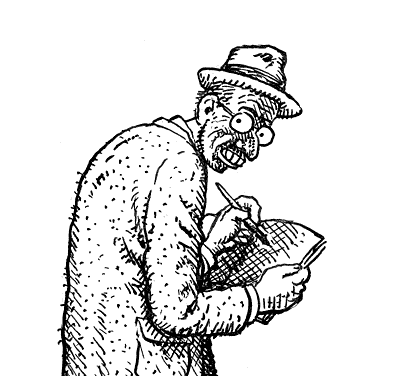American comics were almost entirely childish and pretty insipid after the Senate hearings in the mid-’50s. Unsurprisingly there was a reaction to this, and some cartoonists started putting out alternatives, full of drugs and sex and anti-establishment politics. It got very tied in to the burgeoning hippy movement.
One all-time comics great came out of this movement. Crumb is a pretty twisted person with various misogynist attitudes – the saving grace is that the comics don’t read as if it’s someone telling you how women are, but as confessions of the creator’s wrongheadedness. This was new. He’s produced tons of great comics himself, and he married another extremely talented cartoonist, Aline Kominsky. He got his start working for Harvey Kurtzman on Help! (his successor to Mad), where Fritz the Cat debuted, and then started putting out his own comics. His drawing is superb, harking back to illustration styles before comics, as well as earlier comics like Popeye, and his writing is scabrous and impossible to ignore. As well as being a great creator, he was also the inspiration for the movement, and an influence on pretty much all of it. Crumb’s work has been extensively collected, and most libraries will have something.
Gilbert Shelton
Shelton was, for me, underground comix’s finest entertainer. Fat Freddy’s Cat and The Fabulous Furry Freak Brothers are always funny, as is the less well known superhero parody, Wonder Wart-Hog. The Furry Freak Brothers were a trio of hapless stoners, always in search of a score and a way to pay for it. I can’t find any figures online, but these have been gigantic sellers for decades, and deservedly so, so shouldn’t be at all hard to find.
Harvey Pekar
It’s questionable whether he should belong here, but Pekar’s autobiographical comics are so clearly post-Crumb (and Crumb draws some of them) that this is as good a place to put him as any. They aren’t often pleasant reading, though he has a very good ear for small anecdotes, because of Pekar’s self-loathing, but they are compelling and potent. The movie of American Splendor made him famous, so you should be able to find his work easily.
Undergrounds produced lots of terrific talents. I can’t cover many here, but it’s also worth trying Justin Green, Kim Deitch, Ted Richards, Bill Griffith, Roberta Gregory, Foolbert Sturgeon, Jaxon, Spain, S. Clay Wilson, Rory Hayes and Vaughan and Mark Bode (father and son) among others. Art Spiegelman (see the Raw entry in this series) started in undergrounds, and many of the artists appeared in Raw in later years. Some subgenres split off and produced interesting work too – anthologies Gay Comix and especially Wimmen’s Comix had some terrific cartoonists, for example.

Why wouldn’t Harvey Pekar belong? Did you have another category in mind for him?
I’d like to put in a word for Dori Seda. Very funny and goofy, and if whe were still alive I could imagine her posting on poptimists.
Well, there are all sorts of ways of defining genre. Culturally, Pekar comes along way after the rest, and had no connection with hippy culture (nor does Crumb, but as the inspiration for the movement, he is excused other requirements), and he is a writer rather than a cartoonist, which is very unusual in undergrounds. His subject matter also isn’t that of most undergrounds.
He can as sensibly be placed within the newer confessional-autobiographical genre, which spun off from undergrounds but has separated: we might start with comix luminaries like Crumb and Justin Green, and include Pekar, Eddie Campbell, Chester Brown, Joe Matt, Joe Sacco and many others.
I agree with you about Pekar; generationally he has a kind of unique spot. He’s the same age as the “underground generation,” and he was inspired by their innovations, but he didn’t start creating comics until their movement was waning, when he initiated a new phase of more-or-less straight, “auto-bio” comics that in turn inspired the younger artists you listed. But it was really the Crumb connection that, in his own version of events, egged him into creating, and — from a reader’s point of view — was key to his popularity, at least at first.
The underground artist who, in my opinion, is doing the best work today is (with the possible exception of Crumb, I guess), Kim Deitch. His graphic novel “Boulevard of Broken Dreams” (no connection with Green Day) of a few years back is terrific — in that book and in his series “Stuff of Dreams,” he explores his obsessions with the cartoons, popular songs and films of the 1920s and creates a weirdly coherent fantasy world all his own. I’ve also seen some good later work from Spain, especially his graphic novel adaption of “Nightmare Alley.”
It’s also worth noting that Crumb’s daughter Sophie is producing a lot of comics of her own these days, which I’ve seen in the “alternative” anthology MOME. Her father’s influence is evident.
Good stuff, Martin!
I’d argue that Pekar doesn’t belong on the list because, well, he’s not very good. (and for the record, neither is Sophie Crumb. She’s almost as bad as David Heatley.)
Kim Deitch, however, is amazing.
I think Pekar is a compelling writer, personally.
I found Pekar pretty revelatory when he first appeared. I had had enough of him by the time his cancer book came out (mostly because I didn’t like any of his artists besides Crumb, but maybe for other reasons as well), but I recently started picking up the new issues of American Splendor that Vertigo is putting out — some good artists there now. I think it’s fair to say that he hasn’t progressed much as a writer, if at all, in 25 years or so.